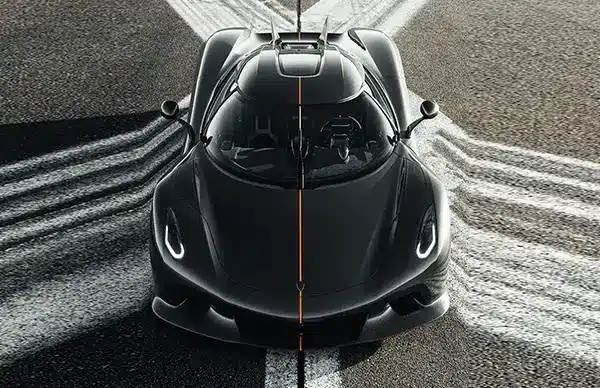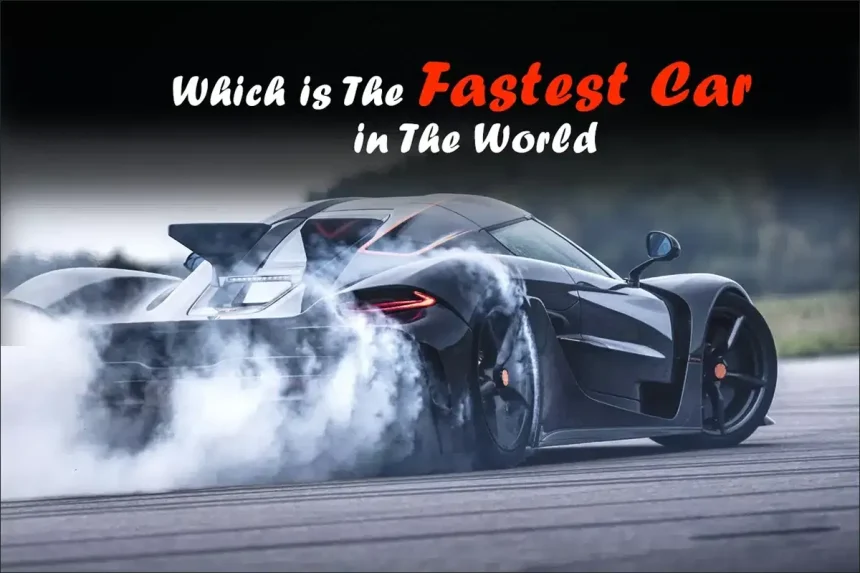Are you driven by the need for speed? If you like the thrill of driving at high speeds and you have to go fast no matter what, there’s a fair chance that you like fast cars. Once upon a time, sports cars were virtually nonexistent in India. But thanks to growing demand, newer sports cars keep getting faster and more affordable. At 355 km/hr, the fastest car in India is currently the Lamborghini Aventador LP 780 4 Ultimate. But do you know which car is the fastest in the world and what its top speed is?
So Which is the fastest car in the world? isn’t a Bugatti, a Ferrari, or a Lamborghini. It’s a hypercar by Koenigsegg Automotive AB, a Swedish car manufacturer popular for its high-performance sportscars.
Which Is The Fastest Car In The World? It’s The Jesko Absolut.
The fastest series-production car in the world is currently the limited-production Koenigsegg Jesko Absolut. This car can reach an estimated speed of 330 mph or 531 km/h.
The Birth Of The Koenigsegg Jesko Absolut
Koenigsegg released teaser sketches of a new car in late 2018. They would soon announce a new hypercar at the Geneva Motor Show and sell all 125 models before the show ended. This car, priced at an estimated $3 million a piece, was also declared to be the fastest-production car in the world. The Jesko, which is the fastest car in the world, is named in honor of founder and CEO Christian von Koenigsegg’s father, Jesko von Koenigsegg.
The Jesko is Koenigsegg’s highest-volume production run yet and their first vehicle to be homologated worldwide. It was officially revealed online on March 3, 2020. Koenigsegg has engineered two versions of the Jesko. The Jesko Attack has a high downforce and has been optimized for the racetrack. The Jesko Absolut is a higher-speed version, which is currently the fastest car in the world.
Did You Know?
Before its name became public, rumors stated that the Jesko was going to be called ‘Ragnarok’.
Below The Hood
The Jesko, which is the fastest car in the world, isn’t fast just because of its aerodynamic design. Underneath its sleek hood is a specially engineered engine that was optimized for speed above everything else. The 5-liter Koenigsegg twin-turbocharged V8 engine produces 1280 bhp (1600 when using E85 fuel) and is mated to a 9-speed multi-clutch Koenigsegg Light Speed gearbox.
The Jesko’s engine features the lightest crankshaft in the world. This 180-degree flat-plane V8 weighs only 12.5 kg. It manages to produce more power and has a rev limit of 8500 rpm. Dr. Thomas Johansson, Koenigsegg’s engine architect, has managed to design super-light connecting rods and pistons that effectively counter the vibrations that the flat-plane engine generates.
Also Read: This Ferrari SUV Is Powerful and Stylish
Nobody Can Drag The Jesko Down
The Absolut serves a different purpose from the Jesko Attack. The Attack’s carbon-fiber front splitter and large rear wing may serve it well on the track, but it would only slow the Absolut down. So the Jeep’s speed-oriented twin was given redesigned front louvers, more aerodynamic front splitter winglets, and removable wheel covers.
The Jesko Absolut needed to be more aerodynamic than the Attack. This would only be possible with a lower drag coefficient. A drag coefficient is a measure of how well the car can move through the air. Lower drag means lower wind resistance, which would help the car reach higher speeds.
Koenigsegg’s team went through every method possible to reduce the drag coefficient. They made every surface slicker so air would glide over it easily. It sports front underbody flaps, dished rear wheels, and a long tail too—all done to minimize drag. The Jesko’s massive rear wing was replaced by rear fins, which reduced downforce from 1400 kg to 150 kg. It was modified to be 85 mm longer, with a more streamlined, teardrop shape. All these changes managed to pull the Absolut’s drag coefficient down to 0.278 Cd.
Designed to Delight

The Koenigsegg Jesko Absolut is a two-door, two-seater car with a removable roof and roof storage. Its doors and hood can be remotely operated thanks to its ‘Autoskin’ ability. You can also hydraulically lift the front and rear axles to adjust ground clearance. Its carbon fiber monocoque chassis is light yet sturdy.
When you step out of the Jesko, its special Koenigsegg doors fold outward and move out of your way to give you more space to get in and out with ease. What’s more, you can open and close the doors by pressing the coat of arms on the inside or a discreet button on the black cladding outside.
Also Read: The Most Attractive Lotus Sports Car
A Light Yet Luxurious Interior
Though the Koenigsegg Jesko was designed to be as light as possible, it is still equipped with all the standard amenities one requires in a car. It comes with standard automatic climate control, seat heating, a 9-inch infotainment screen, a hand-made analog G-force meter, ambient lighting, and more. One of its most impressive features is a 5-inch digital instrument cluster that is mounted behind the steering wheel. As the wheel turns, the screen turns as well, but the information it displays remains upright and easily readable.
Many parts of the interior feature Koenigsegg branding; the passenger-side dash and floorboards bear ‘Jesko’ lettering, the doors, pedals, and key feature the coat of arms logo, while the steering has both the text and Koenegsiss logo.
The Jesko is equipped with hollow carbon-fiber seat shells and electrically adjustable sport bucket seats fitted with memory foam. These seats look like gaming chairs, and not in a bad way. They have a sporty and futuristic look and have been designed to be light and comfortable. The client can choose between Alcantara or custom leather upholstery in a wide range of color and contrast options.
Also Read: Newest Aston Martin Sports Car in India
Taking names, breaking records
How do people actually prove which is the fastest car in the world? Companies may promise speeds, but only road tests can prove how practical those estimated speeds are. The Jesko’s top speed is possible in theory, but to actually set the record for ‘the fastest production car’ requires a lot more.
This record requires a place where it will be possible to test this kind of speed. The current record for the fastest production car is 300 mph or close to 500 kmph. Car manufacturers face a few difficulties while breaking this record: they need a stretch of straight road where the car can legally drive past 300 mph with no other cars in sight. The weather has to be perfect, and the car’s tires need to be legally approved for that kind of speed.
In short, while computer algorithms and simulations can provide estimated numbers, proving which is the fastest car in the world in real life is pretty difficult. According to Koenigsegg’s CEO, the company is currently in the process of making all the required preparations to make Jesko’s supposed speed a reality.
Also Read: Most Expensive Mercedes-Benz Ever Sold
Speed Demon Extraordinaire
Thankfully, there are certain other records a car can make that can prove its performance and speed capabilities. You see, apart from the record for the fastest production car, there’s others that are equally coveted as well. What the Jesko set out to conquer was the 0-400 km/hr record.
So what does this record entail? It’s simple: you start, accelerate to 400 km/h, and brake to stop as fast as you can. The time you started and when you stopped becomes your 0-400 km/hr time. As you’ve probably realized, this isn’t a test of speed but of the car’s engineering and validation of its traction control, stability control, and anti-lock braking system.
At five in the morning, in an airfield in Rebro, Sweden, test driver Markus Lundh climbed into a Jesko and proceeded to make history. The car was pretty much in stock condition, fitted with Michelin Pilot Sport Cup 2 R tires, and ran on E85 fuel. The only additions were made for safety purposes: a roll cage and a seat taken from the Koenigsegg One:1. Additionally, it was fitted with RaceLogic timing gear.
The Koenigsegg Jesko broke four world records in a single run. Let’s break down which ones.
First, the car accelerated to 400 km/hr in 18.82 seconds, beating the Koenigsegg Regera’s previously set record of 28.81 seconds. In the process, it broke the record for the fastest 0-250 mph in 19.20 seconds. It set another world record by becoming the first production car to reach 250 mph in under 20 seconds. And finally, it managed to go from 0 to 400 km/hr and back to 0 in 27.83 seconds.
What’s In Store For The Absolut?
Koenigsegg has declared that they won’t be building a faster series-production road car than the Absolut. Not now, not in the future. At 330 mph, not many vehicles will come close to this car’s absolutely insane, warp-like speed. Even the track-focused Jesko Attack is speculated to push past Koenigsegg’s estimated top speed of 278 mph.
According to Christian von Koenigsegg, the Jesko Absolut’s 0-400 km/hr records have validated its performance and given the company added confidence in its status as the fastest car in the world. It is highly unlikely that any owners of the Jesko Absolut will drive the car at its actual top speed. There are very few places in the world where you can drive past 300 mph anyway.
But who cares? The Absolut is fast; it looks fantastic, and can you imagine the bragging rights? Priced starting at $3 million and with a limited production of 125 models, Jesko Absolut’s legacy will last a long, long time.
Also Read: The Rolls-Royce Worth $28 Million
Frequently Asked Questions:
How much does the Koenigsegg Jesko Absolut cost?
The price of the Koenigsegg Jesko starts at approximately $3 million.
Which is the fastest car in the world after the Koenigsegg Jesko Absolut?
After the Jesko, the Bugatti Chiron Super Sport 300+ is the fastest car in the world. It can reach a top speed of 300 mph or 490.484 km/h.
How fast can the fastest non-production car go?
763.035 mph, or approximately 1227.985799 km. This record was set by Andy Green driving the ThrustSSC jet car in October 1997. This non-production car is the only vehicle in the world to have traveled faster than the speed of sound.















